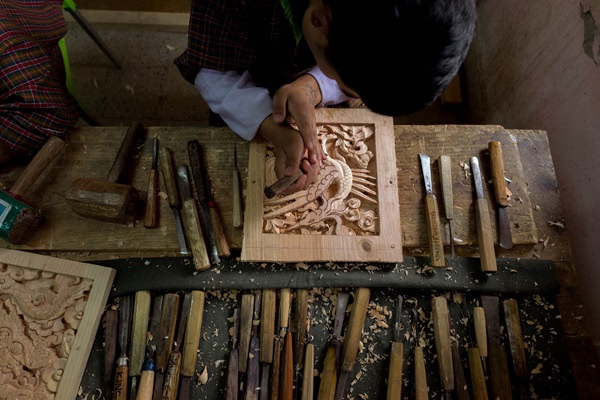
Discover the rich cultural heritage of Bhutan through the 13 arts and crafts of Bhutan, collectively known as Zorig Chusum.
These traditional crafts embody the nation's artistic spirit and craftsmanship, from intricate weaving to masterful woodwork. Learn the fascinating history, meet the talented artisans, and learn how these timeless practices thrive in modern Bhutan.
Join us on this cultural journey and uncover the secrets behind Bhutan's captivating arts and crafts.
1. Shingzo (Carpentry)
One of the most outstanding things you will notice about Bhutan is its distinctive architecture. Carpentry plays a vital role in the construction of Bhutan's majestic dzongs, temples, palaces, and bridges.
These masterpieces, with exquisite design and intricate details, are created by the master carpenters known as Zo Chen and Zo Wo. The ancient fortresses are some of the finest examples of woodwork in the country and are often praised for their uniqueness.
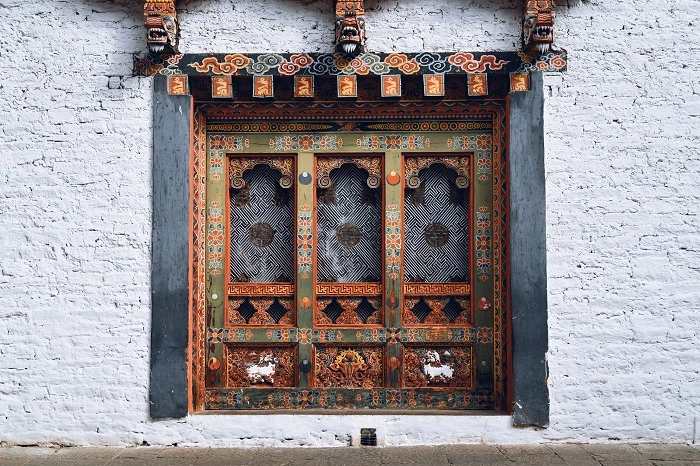
2. Dozo (Masonry)
The ancient craft of dozo refers to building structures using stones. This craft still prevails today and can be seen in the building of chortens, dzongs, temples and houses. Stones are frequently used to construct the walls, and sometimes, the masons also prepare flat stones for the courtyards.
One of the classic examples of a stone structure is Chorten Kora in Trashiyangtse in eastern Bhutan and Chendebji Chorten in central Bhutan.
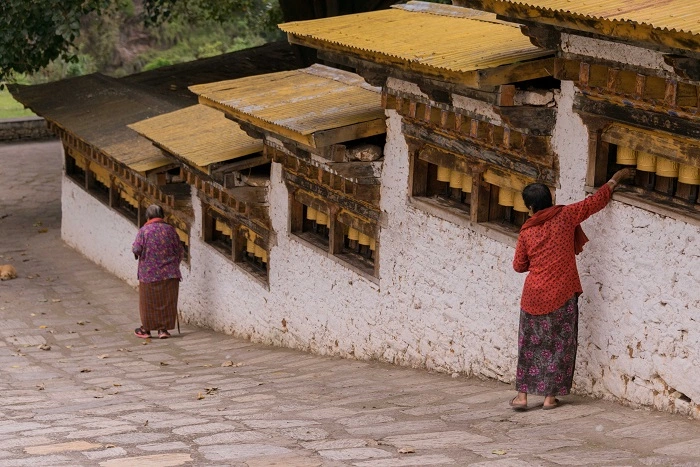
3. Parzo (Carving)
The art of carving, usually on stones, woods and slates, is known as Parzo. Carving is extensively practiced in the country to produce items such as printing blocks for religious texts, furniture, altars, slate images embellished on the many shrines and wooden masks featured during the annual religious festivals.
Slate carvings depicting the Buddha and various other deities can be found in the templesthroughout the country. Aside from the masks, wooden sculptures are commonly seen in Bhutanese products, such as carvings of the eight lucky signs or even phalluses in various sizes and shapes.
These sculptures are usually made of blue pine or walnut and are further enhanced by painting them in vibrant colours.
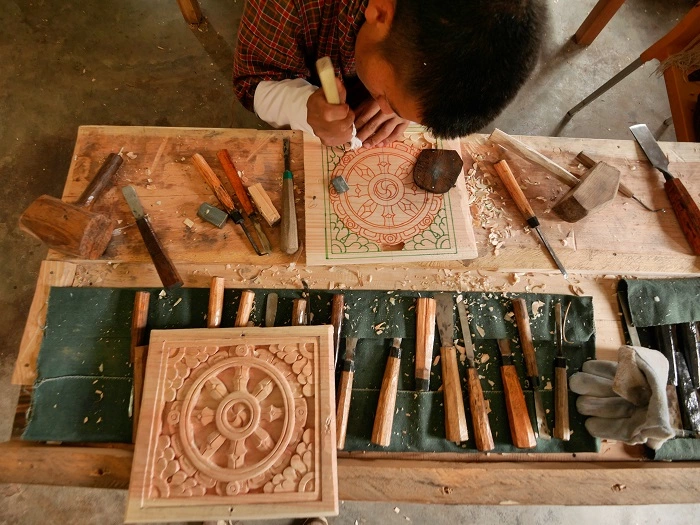
4. Lhazo (Painting)
Bhutanese paintings are an ancient art that has been practiced for many generations. Master painters are known as Lharips,and their work can be seen in the murals and frescoes inside the massive dzongs, temples, and monasteries.
A lhadrip also paints houses with traditional symbols, chosham (altar), thangka, or thongdroel (religious scrolls) with the images of Buddha and other deities. These religious paintings follow precise, symbolic econometric and iconographic rules codified in ancient treaties.
Another striking feature of Bhutanese paintings is anonymity. The lhadrips would never sign on their works and it is believed that the act of creating a religious painting earns great merit and should be done with a pure mind.
Natural pigmented soils are commonly found in Bhutan and used in Bhutanese paintings. Sa-Tshoen (soil pigments) are of different colours, namely black (sa—na), red (tag), and yellow (sa-ser).
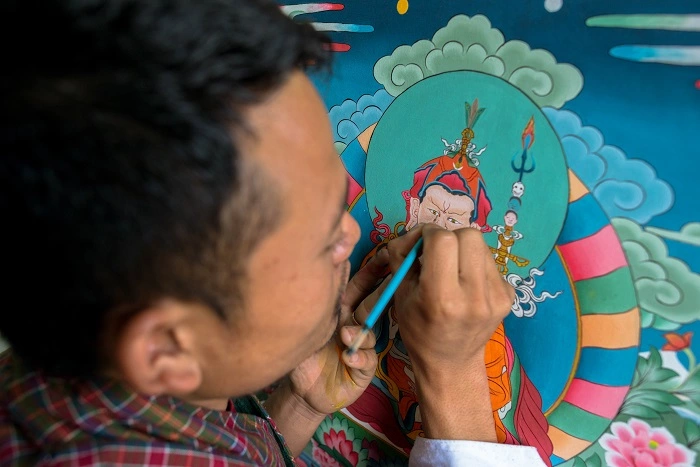
5. Jinzo (Sculpting)
Jinzo (sculpting) is one of the oldest forms of craft, dating back to the 17th century. Jinzo includes making o religious statues and ritual objects, clay masks, pottery and construction of buildings using mortar, plaster and rammed earth.
Usually, the sculpture is made of clay combined with other materials such as traditional desho paper or beaten bark from the Daphne plant. Bhutanese clay sculptures are amongst the best in the Himalayan region, and many renowned sculptors have been invited to build statues in some ancient monasteries in Tibet.
Another popular clay product is the traditional earthen pots. Only a few places in the country still make earthen pots, such as Gangzur gewog in Lhuentse, and astern Bhutan. Tsatsas (sacred objects moulded with clay) are a common sight in Bhutan.
Ashes of the deceased are mixed with clay to make tsatsas. You can find these sacred objects in caves, underneath rocks, inside stupas, alongside the roads or any places that are sheltered from the elements.
They are usually painted in white, red or gold. The bereaved family members usually commission for the production of tsatsas to honour and bid farewell to their loved ones.
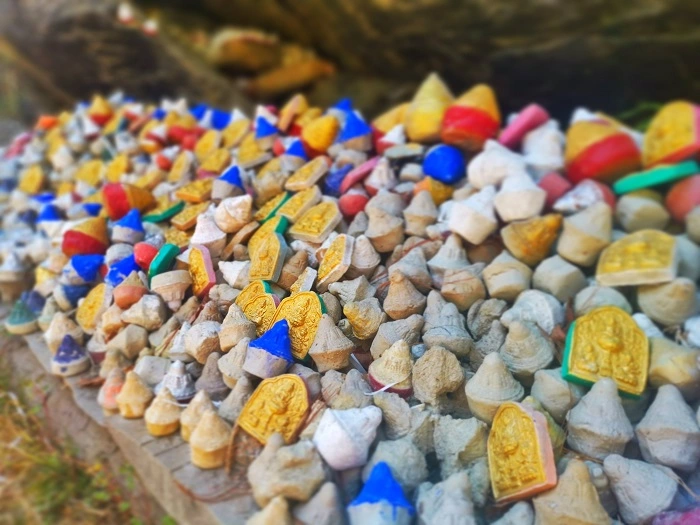
6. Lugzo (Bronze Casting)
Lugzo is the art of casting statues, sertog (pinnacles on the roofs), and other ornaments to decorate the temples and monasteries. The art of bronze casting was first introduced to Bhutan by Newari artisans from Nepal in the 17th century.
Casting involves a complex process, and Bhutanese artisans usually employ two methods of bronze casting: sand and wax. Bronze was also commonly used to cast containers such as cups, urns and vases and shaped into weapons and armors, including axes, helmets, knives, swords and shields.
The 13th Je Khenpo, Gyalsey Tenzin Rabgye crafted 1,000 Buddhas using wax, including the main Buddha at Punakha Dzong using wax.
7. Garzo (Blacksmithing)
The art of ironwork and blacksmithing in Bhutan began in the late 14th century. It is believed the Tibetan saint Dupthob Thangtong introduced this ancient craft to Bhutan. He is skilled in casting iron chains and constructing bridges.
He has built eight suspension bridges in Bhutan, including the bridge over Paro Chu linking the highway to the famous Tachog Lhakhang in Paro. While blacksmithing is almost a dying art in Bhutan, there are still some settlers in Trashigang who are still practicing this craft.

8. Troeko (Ornament Making)
The craft of traditional ornaments made from gold, silver or copper are known as troeko. Usually, stones such as corals and turquoise are integrated with gold or silver to shape out the ornaments. The master craftsmen in jewellery or ornament making are known as Troko Lopen.
These skillful craftsmen create various types of ornaments and jewellery, including necklaces, earrings, brooches, rings, and traditional containers for storing doma.
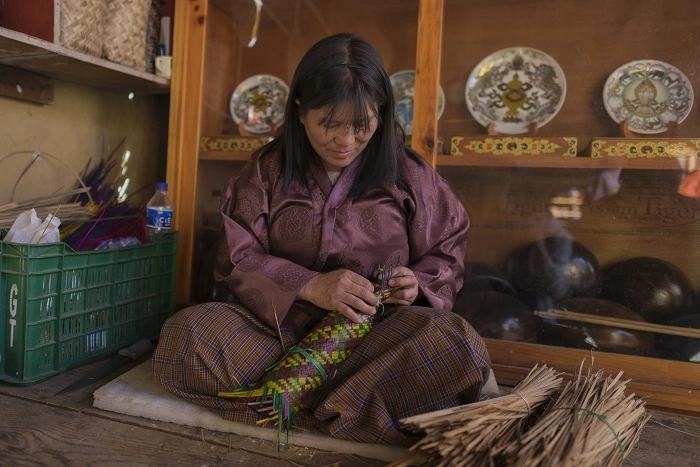
9. Tsharzo (Cane And Bamboo Weaving)
Tsharzo is the art of weaving cane and bamboo to produce household products.
Some of the bamboo products include the commonly used bangchung (a container and serving plates for snacks), covers for religious artefacts, lagchu (quiver for storing arrows), tshogtrhung (vessels for serving food), baekhu (container for wool and threads), and patsha dromchung (container for jewellery).
Tsharzo is the main source of income for people in Trashigang, eastern Bhutan.
10. Thagzo (Weaving)
Thagzo, the art of weaving, is one of the oldest crafts that have been practised for centuries. Weaving is an integral part of Bhutanese life and culture, and the craft is widely practised throughout the country.
Bhutanese textiles are woven from cotton, silk,k, or wool in a striped patterns vertical for men and horizontal for women. However, each region has a speciality in terms of designs and types. Bhutanese textiles are admired for their rich vibrant colours, variations of patterns, intricate ddyeing, and manual weaving techniques.
Some of the most popular textiles are woven by the women from eastern Bhutan. Bhutanese weavers usee three types of loom: the- blackstrap loom,the horizontal-framed loo, and the card loom. The primary type of thagzo is the back-strap loom, which is mostly used by weavers from eastern Bhutan.
The horizontal-framed loom and the card loom were introduced into Bhutan from Tibet and are still used today. Traditionally, when the government collectedt taxes in kind, people paidy taxes using textiles insteadu of money.
11. Tshemzo (Tailoring, Embroidery And Appliqué)
Tshemzo includes three forms of art - tailoring, embroidery and appliqué. Tailoring involves stitching all kinds of garments like the traditional costumes, Gho and Kira, while embroidery and applique are practised by monks to make religious scrolls: thangkas or throngdroel.
Traditional boot making is also a craft that falls under tshemzo. Tsolhams (traditional knee-length boots) are made from brocade and embellished with intricate embroidery. Bhutanese wear these special boots during special occasions and certain religious ceremonies.
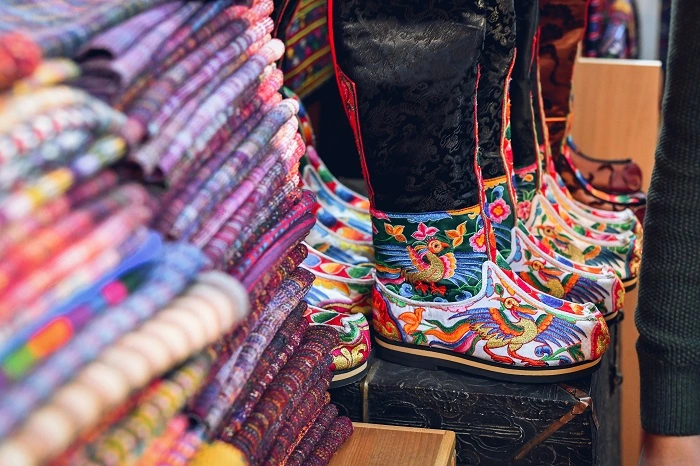
12. Shagzo (Woodturning)
Shagzo, the art of woodturning, is a tradition practiced by the people of eastern Bhutan in Trashiyangtse.
The master craftsmen, Shagzopas are known to produce items such as turned dapas (wooden bowls) and dza phobs (wooden cups) in various shapes and sizes. Other popular items include ara (alcohol) container, utensils and tea kettles.
A wide range of woods are used to produce the items. One of the highly prized raw materials is dza (special wooden knots). These exquisite products can be easily found in the craft markets and are popular as souvenirs.
13. Dezo (Paper-Making)
Dezo, paper-making is another art with deep roots in Bhutan. Traditional paper is made from the bark of a Daphne tree and was widely used in the past.
Traditionally, most religious texts or sacred scriptures were written on desho (traditional Bhutanese paper) using traditional Bhutanese ink or sometimes in gold. Traditional papers are now turned into more contemporary products such as greeting cards, notebooks, wrapping papers, envelopes, or calendars.
The art is still alive in Trashiyangtse where raw material is readily available.
Famous Artisans And Their Masterpieces In Bhutan
Bhutanese artisans, revered for their exceptional skills and dedication, have preserved and enriched the nation’s cultural heritage through their masterpieces.
Pema Tshering - A master of Thangka painting, renowned for his intricate religious artworks that are celebrated both locally and internationally.
Sangay Wangchuk - A virtuoso in woodcarving, known for his exquisite designs that adorn temples and monasteries across Bhutan.
Dechen Choden - Famous for her textile weaving, combining traditional patterns with contemporary aesthetics to create vibrant, intricate fabrics.
These artisans, among others, play a crucial role in preserving and enriching Bhutan's cultural heritage, ensuring that traditional arts and crafts continue to thrive for future generations.
Conclusion About Arts And Crafts In Bhutan
The arts and crafts of Bhutan offer a captivating glimpse into the nation’s rich cultural heritage and artistic prowess. From intricate weaving to masterful wood carving, these traditional crafts reflect the dedication and skill of Bhutanese artisans.
Immerse yourself in Bhutan's rich culture with DrukAsia - a one-stop Bhutan tour agency for your travel!
For those looking for a premium experience, explore our luxury travel in Bhutan offerings. If you're travelling from Malaysia, our guide on travel to Bhutan from Malaysia provides valuable information.
Druk Asia, the best Bhutan tour operator, is here to make your cultural journey unforgettable! Book Now!
Frequently Asked Questions About Arts And Crafts In Bhutan
How Is Bhutanese Art Preserved And Promoted?
Bhutanese art is preserved through cultural institutions, workshops, and artisans who pass their skills to future generations.
Which Art Form Is Most Popular In Bhutan?
Weaving and wood carving are among the most popular art forms, and their exquisite designs can be seen in textiles and religious structures.
What Materials Are Used For Bhutanese Clay Statues?
Bhutanese clay statues, often depicting deities, are crafted from local clay and adorned with intricate details.
Did Bhutanese Artisans Create More Than Just Bridges?
Yes, Bhutanese artisans are known for bridges and their exceptional craftsmanship in wood carving, textiles, and clay statues.
